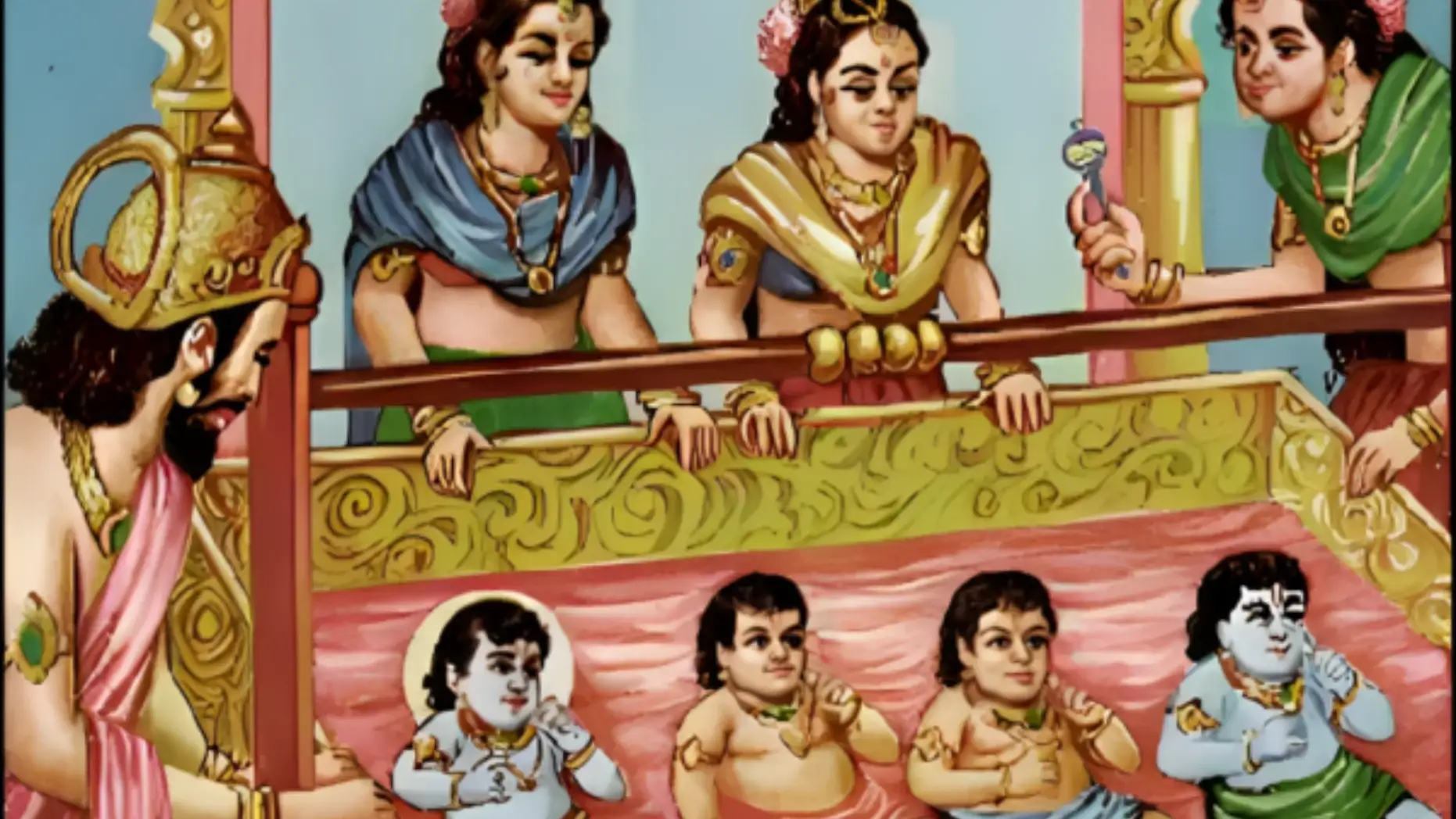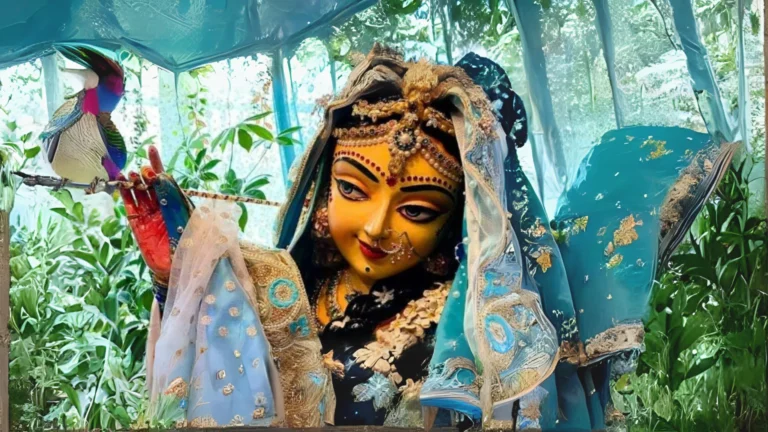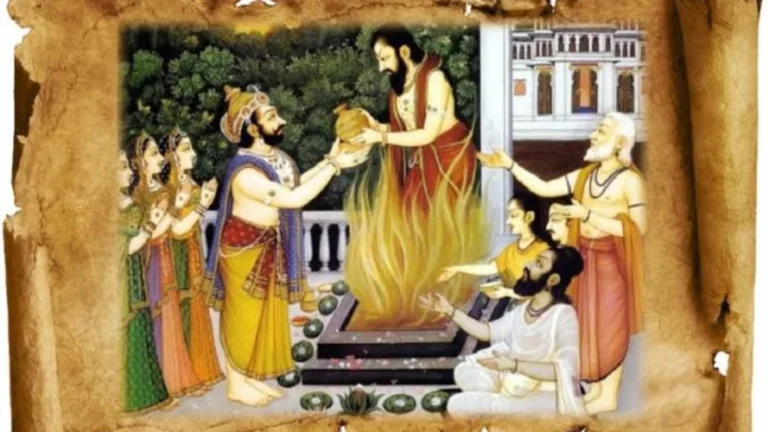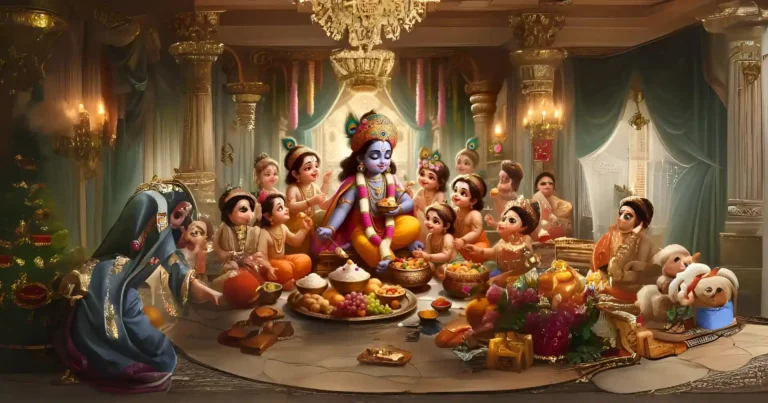Please Like the Blog and Share it for Maximum Reach
Table of Contents
At the kingdom of Ayodhya, the three Queens of Ayodhya delivered 4 children. Sri Rama, the Supreme Personality of Godhead appeared as the son of Queen Kausalya.
He first appeared directly in his four-handed form of Sriman Narayana with the conch, discus, mace, and Lotus flower. He appeared with a dark complexion with a golden yellow lower garment, resplendent like a million suns.
At the request of Queen Kausalya, he assumed the form of an innocent infant, totally dependent on the mother for its survival and upkeep.
Sons of King Dasharatha
Then Queen Sumitra gave birth to the Sesha Avatar, the Incarnation of the Serpent Couch of Lord Narayana Seshanaga. The baby bore the name Laxmana.
Lord Narayana’s conch (Shankh) and Sudarshana Chakra (discus) took the forms and Bharath and Shatrughana and appeared as sons of Queen Kaikeyi. It is important to note that in the Valmiki Ramayana, Kaikeyi’s son was Bharatha.
Sumitra had twins Laxmana and Shatrughna.
Interestingly, in the Ananda Ramayana, sage Valmiki writes that Bharatha and Shatrughna were the twin sons of Kaikeyi while Sumitra had just one son, Laxmana.
Performing the Samskaras of the Princes
When the four boys, made their appearance in the Raghu kula (Raghu dynasty), the Devatas started playing kettle drums. This was in anticipation of the destruction of the demon king Ravana, for which these four princes had made their earthly appearance.

The skies started pouring out flowers, covering the earth’s surface with divine flowers, announcing the happiness of the upper worlds.
King Dasharatha requested sage Vashishtha, his chief preceptor to conduct the Nama Samskara (Child Naming Ceremony) and also include them into the fold of Kshatriyas.
What is the Importance of the Samskaras?
This, we call, the Jata Samskara.
According to Sanatana Dharma, every human being, born to parents in the Varna Ashrama system, is initially born as a Shudra, one of the 4th Class.
Then the parents conduct many Samskaras on the child, by inviting priests to perform the elaborate rituals. Thus families of the various Varnas, through these Ceremonies include their newborn child from the Shudra class to the class that they belong to.
It is worthwhile to note that the Varna Ashrama System was not a divisive mechanism to create rift, as many of the modern intellectuals or so-called social-reformers think. The concept of caste never existed in those times.
The Varna Ashrama system was based on the Karma and Guna of the individuals. For example, a person proficient in a certain talent usually would beget children who were already genetically aligned to the occupation of the fathers. Marriages too were systematically conducted along these lines only.
So it was easier and more natural to them to pick up those skills and contribute positively to society, maintaining the pristine fabric of society. Then Gunas also contributed to the attainment of a particular occupation.
A person with the mood and inclination for a certain proffesion would take it up naturally. A person inclined towards writing, cannot possibly take up pottery. He will be more comfortable to choose writing, irrespective of which proffession would give him a better pay, unlike modern thinking.
People of the olden era were not ambitious and lived to raise their consciousness towards attaining the Supreme, irrespective of their Guna and Karma, unlike the common folks of this day.
Today the Varnas are mixed. Why, there are no varnas anymore. Marriages do not have rules and children are born as admixture of Gunas and Varnas. Live-in relationships are common.
The purity factor of begetting children is totally compromised and caste system and religions of a very cult nature are at its peak. What can we expect out of such a break-down of the pristine system?
But in the days of Yore the Samskara ceremony was universal for anyone who falls in the top 3 Varnas of the Vedic Varna Ashrama System, Brahmin, Kshatriya, or Vaishya.
Test your Alignment with the Spiritual Subject Matter (only 7-8 Questions)
The scores generated in this Quiz are relative. There are no right or wrong answers. A percentage towards 100 indicates that you are more aligned to the overall subject matter.
The Naming and Pairing of the Princes
With pomp and gaiety, King Dasharatha consummated the Nama Samskara ceremonies and all other ceremonies which the newborn has to undergo. The name Rama means the one who gives pleasure to all.
The name Laxmana indicates the one who is full of transcendental qualities. Bharatha indicates one who is always full of the supernal divine qualities. Shatrughna is one, who has conquered his enemies, or the one in whose association, enmity is vanquished.
Sri Rama and Laxmana became a pair and always spent time with each other. Bharatha and Shatrughna always stayed together, inseparable from each other and ready to sacrifice themselves for the other.
Ornamentation of the Princes
The four small princes wore golden bangles and anklets on their feet. The King pierced the ears of the princes and they wore kundalas or earrings, enhancing their overall beauty.
They also wore tiny garlands of gold. In the evenings the four princes would place themselves in swings specially made for them.

These swings were gem-studded and had the finest diamonds stuck on them.
The Princes bring Happiness to the King and Queens
The princes had beautiful curly hair with curls running down their cheeks. The princes always wore a smile that lit up the entire palace. They had tiny white teeth, appearing like tiny bright gems, that could remove the darkness of ignorance from one’s heart.
As time went by, the princes dragged themselves on all fours and were all over the palace, exciting all through their innocent moves and gestures. Their parents, the king, and his three principal queens doted on them.
They were behind them at all times, trying to serve the 4 angels who had descended for a lofty purpose, still unknown to their parents. The king kept his boys bedecked with exquisite ornaments, gem-studded belts, and much more.
He took a special interest in seeing his boys all dressed up.
He would bend forward to have a closer look at his tiny tots and burst into laughter looking at their toddles and innocent gestures and sometimes cry in a fit of parental affection.
Baby Rama picks morsels from the King’s plate
When king Dasharatha sat to have his meals, baby Rama would immediately make his appearance. He would sit on the king’s lap and pick up a few morsels of food from the plate of the king and rush out.

On the king’s calling, Mother Kausalya would rush out to get hold of the baby. The Queen tries to get hold of the tiny prince, but the Lord would always remain out of his mother’s reach.
After making his mother run for a while, baby Rama would suddenly rush back into the palace and place the morsels on his father’s mouth. He would also take a few morsels from the plate to feed his mother.
Mother Kausalya would grab baby Rama and kiss him all over the body. Father Dasharatha would sit looking at the lovely exchanges between mother and son, with drops of tears trickly from his overjoyed eyes.
Sri Rama, the Supreme Lord gave the highest pleasures of parental affection to his parents, King Dasharatha and Queen Kausalya.
The Yagyopaveeta Ceremony
With the passing of a few years, the king became more particular about the princes’ dress. He would ensure that the princes covered themselves with sufficient gold ornaments. The time came when the little prince, Rama, took his position alongside his father on the throne.
It was time for his Yagyopaveeta ceremony, the ceremony of bearing the divine investiture thread.

The top three classes namely the Brahmanas, Kshatriyas, and the Vaishyas bore the sacred thread as part of the Samskara. This was an auspicious moment. The sages and the members of the priestly class at the court waited for the right Muhurta or auspicious time for initiating the prince with the right mantras.
At the right moment, the sages initiated the prince into the Vedic System and the Six Vedic Philosophies. Sri Rama, the Kshatriya Prince absorbed these scriptures without the least difficulty and proved himself worthy of the Yagyopaveeta ceremony.
Until such time that he married, the prince took the vow of celibacy.
Prince Rama undertakes a Pilgrimage
The prince, accompanied by the sages of the court and the army men undertook the sacred pilgrimage. Such a journey, the members of the Raghu clan always undertook at the time of the thread-bearing ceremony.
Then he returned to Ayodhya Puri, after the completion of vows and undertakings at the time of the pilgrimage. The tour lasted for about 6 months. With his appearance, divine qualities, love for family, and country he entranced the entire population of Ayodhya Puri.
Please Like the Blog and Share it for Maximum Reach




